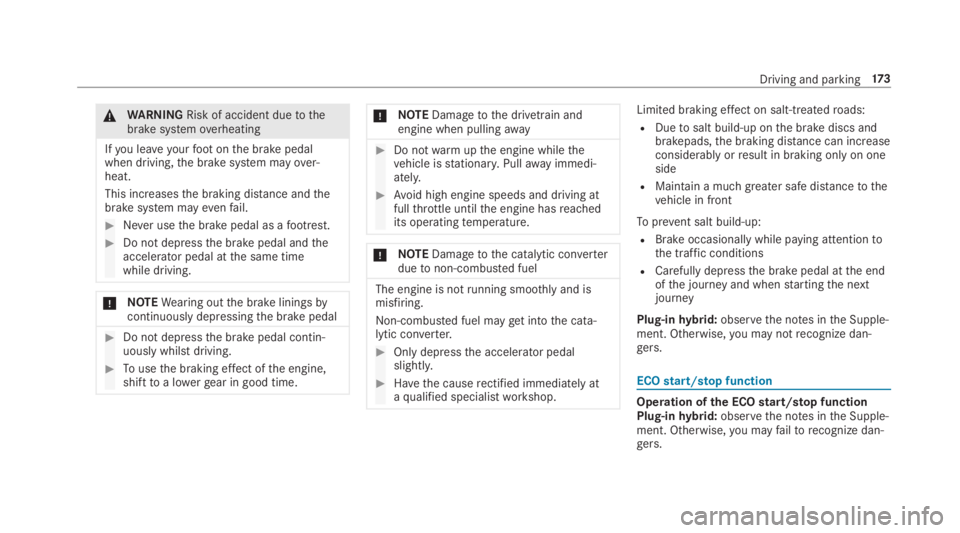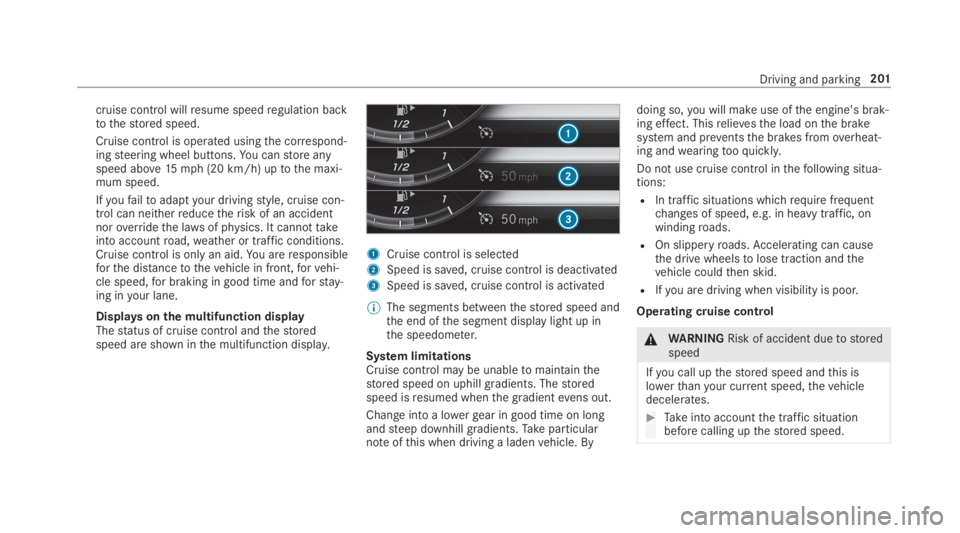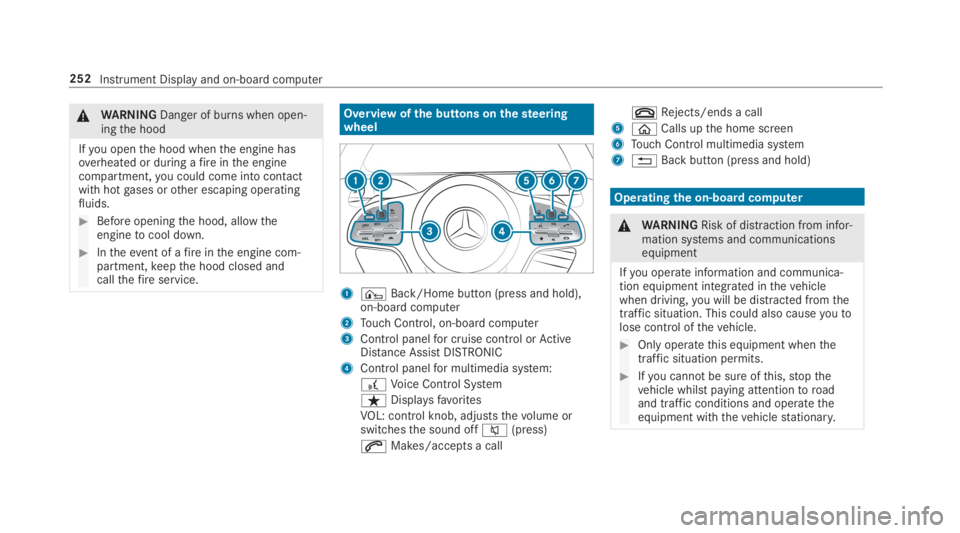2019 MERCEDES-BENZ S CLASS engine overheat
[x] Cancel search: engine overheatPage 175 of 578

&WARNINGRisk of accident duetothebrake systemoverheating
Ifyou leaveyourfootonthe brake pedalwhen driving,the brake system mayover‐heat.
This increasesthe braking distance andthebrake system mayevenfail.
#Never usethe brake pedal as afootrest.
#Do not depressthe brake pedal andtheaccelerator pedal atthe same timewhile driving.
*NOTEWearing outthe brake liningsbycontinuously depressingthe brake pedal
#Do not depressthe brake pedal contin‐uously whilst driving.
#Tousethe braking effect ofthe engine,shifttoa lowergear in good time.
*NOTEDamagetothe drivetrain andengine when pullingaway
#Do notwarmupthe engine whilethevehicle isstationary.Pullawayimmedi‐ately.
#Avoid high engine speeds and driving atfullthrottle untilthe engine hasreachedits operatingtemperature.
*NOTEDamagetothe catalytic converterduetonon-combusted fuel
The engine is notrunning smoothly and ismisfiring.
Non-combusted fuel mayget intothe cata‐lytic converter.
#Only depressthe accelerator pedalslightly.
#Havethe causerectified immediately ataqualified specialistworkshop.
Limited braking effect on salt-treatedroads:
RDuetosalt build-up onthe brake discs andbrakepads,the braking distance can increaseconsiderably orresult in braking only on oneside
RMaintain a much greater safe distancetothevehicle in front
Toprevent salt build-up:
RBrake occasionally while paying attentiontothe traffic conditions
RCarefully depressthe brake pedal atthe endofthe journey and whenstartingthe nextjourney
Plug-inhybrid:observethe notes inthe Supple‐ment. Otherwise,you may notrecognize dan‐gers.
ECOstart/stop function
Operation of the ECOstart/stop functionPlug-inhybrid:observethe notes inthe Supple‐ment. Otherwise,you mayfailtorecognize dan‐gers.
Driving and parking17 3
Page 203 of 578

cruise control willresume speedregulation backtothestored speed.
Cruise control is operated usingthe correspond‐ingsteering wheel buttons.You canstore anyspeed above15mph (20 km/h) uptothe maxi‐mum speed.
Ifyoufailtoadaptyour drivingstyle, cruise con‐trol can neitherreducetherisk of an accidentnoroverridethe lawsof physics. It cannottakeinto accountroad,weather or traffic conditions.Cruise control is only an aid.You areresponsibleforthe distancetothevehicle in front,forvehi‐cle speed,for braking in good time andforstay‐ing inyour lane.
Displaysonthe multifunction displayThestatus of cruise control andthestoredspeed are shown inthe multifunction display.
1Cruise control is selected
2Speed is saved, cruise control is deactivated
3Speed is saved, cruise control is activated
%The segments betweenthestored speed andthe end ofthe segment display light up inthe speedometer.
System limitationsCruise control may be unabletomaintainthestored speed on uphill gradients. Thestoredspeed isresumed whenthe gradientevens out.
Change into a lowergear in good time on longandsteep downhill gradients.Takeparticularnoteofthis when driving a ladenvehicle. By
doing so,you will make use ofthe engine's brak‐ing effect. Thisrelievesthe load onthe brakesystem and preventsthe brakes fromoverheat‐ing andwearingtooquickly.
Do not use cruise control inthefollowing situa‐tions:
RIn traffic situations whichrequire frequentchanges of speed, e.g. in heavy traffic, onwindingroads.
ROn slipperyroads.Accelerating can causethe drive wheelstolose traction andthevehicle couldthen skid.
RIfyou are driving when visibility is poor.
Operating cruise control
&WARNINGRisk of accident duetostoredspeed
Ifyou call upthestored speed andthis islowerthanyour current speed,thevehicledecelerates.
#Takeinto accountthe traffic situationbefore calling upthestored speed.
Driving and parking201
Page 254 of 578

&WARNINGDanger of burns when open‐ingthe hood
Ifyou openthe hood whenthe engine hasoverheated or during afireinthe enginecompartment,you could come into contactwith hotgases orother escaping operatingfluids.
#Before openingthe hood, allowtheenginetocool down.
#Intheevent of afireinthe engine com‐partment,keepthe hood closed andcallthefireservice.
Overview ofthe buttons onthesteeringwheel
1¤Back/Home button (press and hold),on-board computer
2Touch Control, on-board computer
3Control panelfor cruise control orActiveDistance AssistDISTRONIC
4Control panelfor multimedia system:
£Voice Control System
ßDisplaysfavorites
VOL: control knob, adjuststhevolume orswitchesthe sound off�c(press)
�aMakes/accepts a call
�vRejects/ends a call
5�
Page 399 of 578

Opening/closingthe hood
&WARNINGRisk of accident ifthe enginehood is unlatched while driving
An unlocked engine hood may open up whenthevehicle is in motion and blockyour view.
#Never unlatchthe engine hood whiledriving.
#Beforeevery trip, ensurethattheengine hood is latched.
&WARNINGRisk of accident and injurywhen opening and closingthe enginehood
When opening or closingthe engine hood, itmay suddenly drop intothe end position.
There is arisk of injuryfor anyone intheengine hood'srange of movement.
#Only open or closethe engine hoodwhenthere are no persons intheengine hood'srange of movement.
&WARNINGDanger of burns when open‐ingthe hood
Ifyou openthe hood whenthe engine hasoverheated or during afireinthe enginecompartment,you could come into contactwith hotgases orother escaping operatingfluids.
#Before openingthe hood, allowtheenginetocool down.
#Intheevent of afireinthe engine com‐partment,keepthe hood closed andcallthefireservice.
&WARNINGRisk of injuryduetomovingparts
Certain components inthe engine compart‐ment may continuetomoveor suddenlymoveagaineven afterthe ignition has beenswitched off, e.g.the coolerfan.
Makesure ofthefollowing before performingtasks inthe engine compartment:
#Switchthe ignition off.
#Nevertouchthe danger zone surround‐ing moving component parts, e.g.therotation area ofthefan.
#Removejewelry andwatches.
#Keep items of clothing and hairawayfrom moving parts.
&WARNINGRisk of injuryfromtouchingcomponent parts undervoltage
The ignition system andthe fuel injectionsystemworkunder highvoltage. Ifyoutouchcomponent parts which are undervoltage,you couldreceivean electric shock.
#Nevertouch component parts oftheignition system orthe fuel injection sys‐tem whenthe ignition is switched on.
&WARNINGRisk of burns from hot com‐ponent parts inthe engine compartment
Certain components inthe engine compart‐ment can beveryhot, e.g.the engine,theradiator and parts oftheexhaust system.
Maintenance and care397
Page 404 of 578

#Parkthevehicle on a level surface.
#Checkthe coolanttemperature display intheinstrument cluster.The coolanttemperature must be below158 °F (70 °C).
#If necessary,removethe cover.
#Slowly turn cap1counter-clockwisetorelieve overpressure.
#Continue turning cap1counter-clockwiseandremoveit.
The coolant level is correct:
RIfthe engine is cold, uptomarker bar2.
RIfthe engine iswarm, upto0.6 in (1.5 cm)over marker bar2.
#If necessary,add coolantthat has beenapprovedbyMercedes-Benz.RFurther information on coolant:(→page472)
Addingwasherfluidtothe windshieldwasher system
&WARNINGRisk of burns from hot com‐ponent parts inthe engine compartment
Certain component parts inthe engine com‐partment can beveryhot, e.g.the engine,the cooler and parts oftheexhaust system.
#Letthe engine cool down and onlytouchthe component parts describedasfollows.
&WARNINGDanger of burns when open‐ingthe hood
Ifyou openthe hood whenthe engine hasoverheated or during afireinthe enginecompartment,you could come into contactwith hotgases orother escaping operatingfluids.
#Before openingthe hood, allowtheenginetocool down.
#Intheevent of afireinthe engine com‐partment,keepthe hood closed andcallthefireservice.
&WARNING‑ Risk offireand injury fromwindshieldwasher concentrate
Windshieldwasher concentrate is highlyflammable. It could ignite if it comes intocontact withhot engine component parts ortheexhaust system.
#Make surethat no windshieldwasherconcentrate spills out nexttothefilleropening.
402Maintenance and care
Page 475 of 578

Information on coolant isavailable atthefol‐lowing locations:
RInthe Mercedes-Benz SpecificationforOperating Fluids310.1
-Athttp://bevo.mercedes-benz.com
-Inthe Mercedes-Benz BeVo app
RAtaqualified specialistworkshop
*NOTEOverheating at high outsidetem‐peratures
If an inappropriate coolant is used,theengine cooling system is not sufficiently pro‐tected againstoverheating and corrosion athigh outsidetemperatures.
#Always use coolant approvedbyMercedes-Benz.
#Observethe instructions intheMercedes-Benz Specificationsfor Oper‐ating Fluids310.1.
Havethe coolantregularlyreplaced at aqualifiedspecialistworkshop.
The proportion of corrosion inhibitor/antifreezeconcentrate inthe engine cooling system shouldbe:
Ra minimum of 50% (antifreeze protectiondowntoapproximately -35 °F (-37 °C))
Ra maximum of 55% (antifreeze protectiondownto-49 °F (-45 °C))
Coolant capacity
SedanCapacity
S 450 4MATIC13.9 US qt(13.2 liters)
S 560 4MATIC15.0 US qt(14.2 liters)
Long wheelbasevehiclesCapacity
S 450 4MATIC
S 450
13.9 US qt(13.2 liters)
Allother models15.0 US qt(14.2 liters)
Mercedes‑MaybachCapacity
S 650 Mercedes-May‐bach16.9 US qt(16.0 liters)
S 560 4MATICMercedes-Maybach15.0 US qt(14.2 liters)
Notes on windshieldwasher fluid
Observethe notes on operatingfluids(→page 468).
&WARNING‑ Risk offireand injury fromwindshieldwasher concentrate
Windshieldwasher concentrate is highlyflammable. It could ignite if it comes intocontact withhot engine component parts ortheexhaust system.
#Make surethat no windshieldwasherconcentrate spills out nexttothefilleropening.
Technical data473